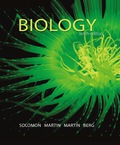
Concept explainers
Test Your Understanding
1. Transmembrane proteins (a) are peripheral proteins (b) receptor proteins (c) extend completely through the membrane (d) extend along the surface of the membrane (e) are secreted from the cell
Introduction: Membrane proteins are a part of biological membrane that primarily interacts with it to perform various functions in the cell. There are various membrane proteins that help in the transportation of molecules in and out of the cell. Based on extend of attachment to the membrane, the membrane proteins are classified as integral proteins, peripheral proteins, and transmembrane proteins.
Answer to Problem 1TYU
Correct answer: Transmembrane proteins are the proteins that extend completely through the membrane. Hence, the correct answer is option (c).
Explanation of Solution
Reason for the correct answer:
Transmembrane proteins are much larger than the lipids molecule, therefore it extends completely through the membrane. These types of proteins majorly function on both sides of the layer (intracellular and extracellular) and help to transport molecules across it. Transmembrane proteins have nonpolar residues where they are embedded in the protein membrane. For maintaining stability within the bilayer, residues of transmembrane proteins form hydrophobic coils and helix such as α-helix and β-pleated sheets.
Option (c) is given as “extends completely through the membrane”.
Transmembrane proteins are much larger than the lipids molecule, therefore it extends completely through the membrane.
Hence, the correct answer is option (c).
Reasons for incorrect answers:
Option (a) is given as “are peripheral proteins”.
This is incorrect because peripheral membrane proteins are located on the inner and outer surface of the plasma membrane and are not embedded in the lipid bilayer as the other membrane proteins.
Hence, option (a) is incorrect.
Option (b) is given as “are receptor proteins”.
This is incorrect because receptor proteins either occur as intracellular receptors (located on the cytoplasm) or cell-surface receptors (located on cell surface) and do not extend completely through the membrane as the transmembrane proteins.
Hence, option (b) is incorrect.
Option (d) is given as “extended along the surface of the membrane”.
This is incorrect because transmembrane protein does not extend along the surface of the membrane like integral proteins.
Hence, option (d) is incorrect.
Option (e) is given as “are secreted from the cell”.
Transmembrane proteins are not secretary proteins that are secreted from cells. They are synthesized and modified in the ER and then transported into the cell membrane.
Hence, option (e) is incorrect.
Hence, the options (a), (b), (d), and (e) are incorrect.
Transmembrane proteins consist of nonpolar residues where they are embedded in the protein membrane and extend completely through the membrane.
Want to see more full solutions like this?
Chapter 5 Solutions
EBK BIOLOGY
- Noggin mutation: The mouse, one of the phenotypic consequences of Noggin mutationis mispatterning of the spinal cord, in the posterior region of the mouse embryo, suchthat in the hindlimb region the more ventral fates are lost, and the dorsal Pax3 domain isexpanded. (this experiment is not in the lectures).a. Hypothesis for why: What would be your hypothesis for why the ventral fatesare lost and dorsal fates expanded? Include in your answer the words notochord,BMP, SHH and either (or both of) surface ectoderm or lateral plate mesodermarrow_forwardNot part of a graded assignment, from a past midtermarrow_forwardNot part of a graded assignment, from a past midtermarrow_forward
- please helparrow_forwardWhat does the heavy dark line along collecting duct tell us about water reabsorption in this individual at this time? What does the heavy dark line along collecting duct tell us about ADH secretion in this individual at this time?arrow_forwardBiology grade 10 study guidearrow_forward
 Biology (MindTap Course List)BiologyISBN:9781337392938Author:Eldra Solomon, Charles Martin, Diana W. Martin, Linda R. BergPublisher:Cengage Learning
Biology (MindTap Course List)BiologyISBN:9781337392938Author:Eldra Solomon, Charles Martin, Diana W. Martin, Linda R. BergPublisher:Cengage Learning Anatomy & PhysiologyBiologyISBN:9781938168130Author:Kelly A. Young, James A. Wise, Peter DeSaix, Dean H. Kruse, Brandon Poe, Eddie Johnson, Jody E. Johnson, Oksana Korol, J. Gordon Betts, Mark WomblePublisher:OpenStax College
Anatomy & PhysiologyBiologyISBN:9781938168130Author:Kelly A. Young, James A. Wise, Peter DeSaix, Dean H. Kruse, Brandon Poe, Eddie Johnson, Jody E. Johnson, Oksana Korol, J. Gordon Betts, Mark WomblePublisher:OpenStax College Biology: The Dynamic Science (MindTap Course List)BiologyISBN:9781305389892Author:Peter J. Russell, Paul E. Hertz, Beverly McMillanPublisher:Cengage Learning
Biology: The Dynamic Science (MindTap Course List)BiologyISBN:9781305389892Author:Peter J. Russell, Paul E. Hertz, Beverly McMillanPublisher:Cengage Learning
 Biology Today and Tomorrow without Physiology (Mi...BiologyISBN:9781305117396Author:Cecie Starr, Christine Evers, Lisa StarrPublisher:Cengage Learning
Biology Today and Tomorrow without Physiology (Mi...BiologyISBN:9781305117396Author:Cecie Starr, Christine Evers, Lisa StarrPublisher:Cengage Learning Human Heredity: Principles and Issues (MindTap Co...BiologyISBN:9781305251052Author:Michael CummingsPublisher:Cengage Learning
Human Heredity: Principles and Issues (MindTap Co...BiologyISBN:9781305251052Author:Michael CummingsPublisher:Cengage Learning





